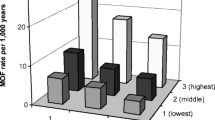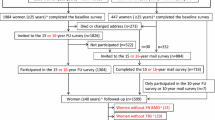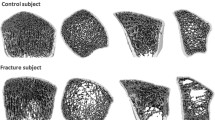Abstract
The use of bone mineral density (BMD) for fracture discrimination may be improved by considering bone microarchitecture. Texture parameters such as trabecular bone score (TBS) or mean Hurst parameter (H) could help to find women who are at high risk of fracture in the non-osteoporotic group. The purpose of this study was to combine BMD and microarchitectural texture parameters (spine TBS and calcaneus H) for the detection of osteoporotic fractures. Two hundred and fifty five women had a lumbar spine (LS), total hip (TH), and femoral neck (FN) DXA. Additionally, texture analyses were performed with TBS on spine DXA and with H on calcaneus radiographs. Seventy-nine women had prevalent fragility fractures. The association with fracture was evaluated by multivariate logistic regressions. The diagnostic value of each parameter alone and together was evaluated by odds ratios (OR). The area under curve (AUC) of the receiver operating characteristics (ROC) were assessed in models including BMD, H, and TBS. Women were also classified above and under the lowest tertile of H or TBS according to their BMD status. Women with prevalent fracture were older and had lower TBS, H, LS-BMD, and TH-BMD than women without fracture. Age-adjusted ORs were 1.66, 1.70, and 1.93 for LS, FN, and TH-BMD, respectively. Both TBS and H remained significantly associated with fracture after adjustment for age and TH-BMD: OR 2.07 [1.43; 3.05] and 1.47 [1.04; 2.11], respectively. The addition of texture parameters in the multivariate models didn’t show a significant improvement of the ROC-AUC. However, women with normal or osteopenic BMD in the lowest range of TBS or H had significantly more fractures than women above the TBS or the H threshold. We have shown the potential interest of texture parameters such as TBS and H in addition to BMD to discriminate patients with or without osteoporotic fractures. However, their clinical added values should be evaluated relative to other risk factors.



Similar content being viewed by others
References
Ballane G, Cauley JA, Luckey MM, Fuleihan GE-H (2014) Secular trends in hip fractures worldwide: opposing trends East versus West. J Bone Miner Res 29(8):1745–1755
Johnell O, Kanis JA (2006) An estimate of the worldwide prevalence and disability associated with osteoporotic fractures. Osteoporos Int 17(12):1726–1733
Marshall D, Johnell O, Wedel H (1996) Meta-analysis of how well measures of bone mineral density predict occurrence of osteoporotic fractures. BMJ 312(7041):1254–1259
Schuit SC, van der Klift M, Weel AEA, de Laet CED, Burger H, Seeman E et al (2004) Fracture incidence and association with bone mineral density in elderly men and women: the Rotterdam study. Bone 34(1):195–202
Sornay-Rendu E, Munoz F, Garnero P, Duboeuf F, Delmas PD (2005) Identification of osteopenic women at high risk of fracture: the OFELY study. J Bone Miner Res 20(10):1813–1819
Ott SM, Kilcoyne RF, Chesnut CH (2009) Ability of four different techniques of measuring bone mass to diagnose vertebral fractures in postmenopausal women. J Bone Miner Res 2(3):201–210
NIH Consensus Development Panel on Osteoporosis Prevention (2001) Diagnosis, and therapy. Osteoporosis prevention, diagnosis, and therapy. J Am Med Assoc 285(6):785–795
Kleerekoper M, Villanueva AR, Stanciu J, Rao DS, Parfitt AM (1985) The role of three-dimensional trabecular microstructure in the pathogenesis of vertebral compression fractures. Calcif Tissue Int 37(6):594–597
Bouxsein ML, Boyd SK, Christiansen BA, Guldberg RE, Jepsen KJ, Müller R (2010) Guidelines for assessment of bone microstructure in rodents using micro-computed tomography. J Bone Miner Res 25(7):1468–1486
Boutroy S, Bouxsein ML, Munoz F, Delmas PD (2005) In vivo assessment of trabecular bone microarchitecture by high-resolution peripheral quantitative computed tomography. J Clin Endocrinol Metab 90(12):6508–6515
MacNeil JA, Boyd SK (2007) Accuracy of high-resolution peripheral quantitative computed tomography for measurement of bone quality. Med Eng Phys 29(10):1096–1105
Melton LJ, Riggs BL, Keaveny TM, Achenbach SJ, Hoffmann PF, Camp JJ et al (2007) Structural determinants of vertebral fracture risk. J Bone Miner Res 22(12):1885–1892
Lespessailles E, Roux JP, Benhamou CL, Arlot ME, Eynard E, Harba R et al (1998) Fractal analysis of bone texture on os calcis radiographs compared with trabecular microarchitecture analyzed by histomorphometry. Calcif Tissue Int 63:121–125
Le Corroller T, Halgrin J, Pithioux M, Guenoun D, Chabrand P, Champsaur P (2011) Combination of texture analysis and bone mineral density improves the prediction of fracture load in human femurs. Osteoporos Int 23(1):163–169
Kolta S, Paratte S, Amphoux T, Persohn S, Campana S, Skalli W et al (2011) Bone texture analysis of human femurs using a new device (BMA™) improves failure load prediction. Osteoporos Int 23(4):1311–1316
Guenoun D, Le Corroller T, Acid S, Pithioux M, Pauly V, Ariey-Bonnet D et al (2013) Radiographical texture analysis improves the prediction of vertebral fracture: an ex vivo biomechanical study. Spine 38(21):E1320–E1326
Roux JP, Wegrzyn J, Boutroy S, Bouxsein ML, Hans D, Chapurlat R (2013) The predictive value of trabecular bone score (TBS) on whole lumbar vertebrae mechanics: an ex vivo study. Osteoporos Int 24(9):2455–2460
Winzenrieth R, Dufour R, Pothuaud L, Hans D (2009) A retrospective case-control study assessing the role of trabecular bone score in postmenopausal caucasian women with osteopenia: analyzing the odds of vertebral fracture. Calcif Tissue Int 86(2):104–109
Silva BC, Leslie WD, Resch H, Lamy O, Lesnyak O, Binkley N et al (2014) trabecular bone score: a noninvasive analytical method based upon the dxa image. J Bone Miner Res 29(3):518–530
Jennane R, Harba R, Lemineur G, Bretteil S, Estrade A, Benhamou CL (2007) Estimation of the 3D self-similarity parameter of trabecular bone from its 2D projection. Med Image Anal 11(1):91–98
Boutroy S, Hans D, Sornay-Rendu E, Vilayphiou N, Winzenrieth R, Chapurlat R (2012) Trabecular bone score improves fracture risk prediction in non-osteoporotic women: the OFELY study. Osteoporos Int 24(1):77–85
Hans D, Goertzen AL, Krieg M-A, Leslie WD (2011) Bone microarchitecture assessed by TBS predicts osteoporotic fractures independent of bone density: the manitoba study. J Bone Miner Res 26(11):2762–2769
Lespessailles E, Gadois C, Kousignian I, Neveu JP, Fardellone P, Kolta S et al (2008) Clinical interest of bone texture analysis in osteoporosis: a case control multicenter study. Osteoporos Int 19(7):1019–1028
Benhamou C-L, Poupon S, Lespessailles E, Loiseau S, Jennane R, Siroux V et al (2001) Fractal analysis of radiographic trabecular bone texture and bone mineral density: two complementary parameters related to osteoporotic fractures. J Bone Miner Res 16(4):697–704
Bousson V, Bergot C, Sutter B, Levitz P, Cortet B, Scientific Committee of the Groupe de Recherche et d’Information sur les Ostéoporoses (2012) Trabecular bone score (TBS): available knowledge, clinical relevance, and future prospects. Osteoporos Int. 23(5):1489–1501
Jennane R, Ohley WJ, Majumdar S, Lemineur G (2001) Fractal analysis of bone X-ray tomographic microscopy projections. IEEE Trans Med Imaging 20(5):443–449
Pothuaud L, Carceller P, Hans D (2008) Correlations between grey-level variations in 2D projection images (TBS) and 3D microarchitecture: applications in the study of human trabecular bone microarchitecture. Bone 42(4):775–787
Rabier B, Héraud A, Grand-Lenoir C, Winzenrieth R, Hans D (2010) A multicentre, retrospective case–control study assessing the role of trabecular bone score (TBS) in menopausal Caucasian women with low areal bone mineral density (BMDa): analysing the odds of vertebral fracture. Bone 46(1):176–181
Pothuaud L, Barthe N, Krieg M-A, Mehsen N, Carceller P, Hans D (2009) Evaluation of the potential use of trabecular bone score to complement bone mineral density in the diagnosis of osteoporosis: a preliminary spine bmd–matched, case-control study. J Clin Densitom 12(2):170–176
Iki M, Tamaki J, Kadowaki E, Sato Y, Dongmei N, Winzenrieth R et al (2014) Trabecular bone score (TBS) predicts vertebral fractures in Japanese women over 10 years independently of bone density and prevalent vertebral deformity: the Japanese population-based osteoporosis (JPOS) cohort study. J Bone Miner Res 29(2):399–407
Briot K, Paternotte S, Kolta S, Eastell R, Reid DM, Felsenberg D et al (2013) Added value of trabecular bone score to bone mineral density for prediction of osteoporotic fractures in postmenopausal women: the OPUS study. Bone 57(1):232–236
Lespessailles E, Gadois C, Lemineur G, Do-Huu JP, Benhamou L (2007) Bone texture analysis on direct digital radiographic images: precision study and relationship with bone mineral density at the os calcis. Calcif Tissue Int 80(2):97–102
Benhamou CL, Lespessailles E, Jacquet G, Harba R, Jennane R, Loussot T et al (1994) Fractal organization of trabecular bone images on calcaneus radiographs. J Bone Miner Res 9(12):1909–1918
Mandelbrot BB, Van Ness JW (1968) Fractional brownian motions, fractional noises and applications. SIAM Rev 10(4):422–437
Lundahl T, Ohley WJ, Kay SM, Siffert R (1986) Fractional brownian motion: a maximum likelihood estimator and its application to image texture. IEEE Trans Med Imaging 5(3):152–161
Pothuaud L, Lespessailles E, Harba R, Jennane R, Royant V, Eynard E et al (1998) Fractal analysis of trabecular bone texture on radiographs: discriminant value in postmenopausal osteoporosis. Osteoporos Int 8:618–625
Albrand G, Munoz F, Sornay-Rendu E, DuBoeuf F, Delmas PD (2003) Independent predictors of all osteoporosis-related fractures in healthy postmenopausal women: the OFELY study. Bone 32(1):78–85
Acknowledgments
We are grateful to Farida Khacef and Nathalie Villequenault for their help in this study.
Conflict of interest
R. Winzenrieth is employed by the Med-Imaps group. J. Chaintreuil was employed at D3A Medical Systems when the work was initiated, then at the Med-Imaps group. D. Hans is CEO of the Med-Imaps group, co-owner of the TBS patent, and has corresponding ownership shares in the Med-Imaps group. J. Touvier, H. Johansson, H. Toumi, J. P. Roux, R. Jennane, and E. Lespessailles have declared no conflicts of interest.
Human and Animal Rights and Informed Consent
This study is in accordance with the Declaration of Helsinki and the International Conference on Harmonization of Good Clinical Practice Guidelines. Additionally, the protocol was approved by an independent regional ethics committee. All the patients and control women entered into the study after written informed consent.
Author information
Authors and Affiliations
Corresponding author
Rights and permissions
About this article
Cite this article
Touvier, J., Winzenrieth, R., Johansson, H. et al. Fracture Discrimination by Combined Bone Mineral Density (BMD) and Microarchitectural Texture Analysis. Calcif Tissue Int 96, 274–283 (2015). https://doi.org/10.1007/s00223-015-9952-1
Received:
Accepted:
Published:
Issue Date:
DOI: https://doi.org/10.1007/s00223-015-9952-1




